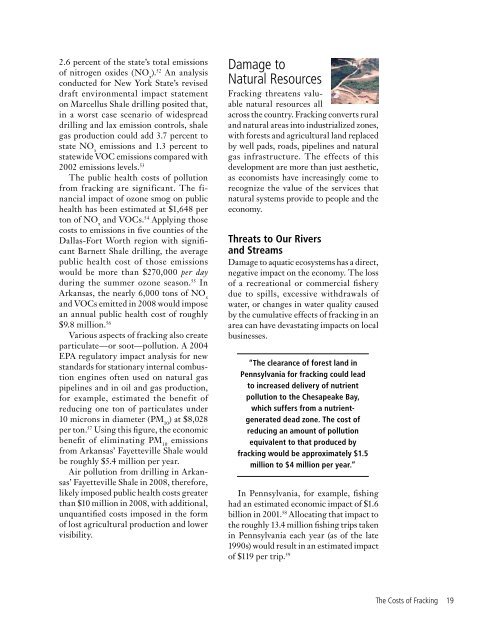The Costs of Fracking
The Costs of Fracking vMN.pdf - Environment Minnesota
The Costs of Fracking vMN.pdf - Environment Minnesota
Create successful ePaper yourself
Turn your PDF publications into a flip-book with our unique Google optimized e-Paper software.
2.6 percent <strong>of</strong> the state’s total emissions<br />
<strong>of</strong> nitrogen oxides (NO x<br />
). 52 An analysis<br />
conducted for New York State’s revised<br />
draft environmental impact statement<br />
on Marcellus Shale drilling posited that,<br />
in a worst case scenario <strong>of</strong> widespread<br />
drilling and lax emission controls, shale<br />
gas production could add 3.7 percent to<br />
state NO x<br />
emissions and 1.3 percent to<br />
statewide VOC emissions compared with<br />
2002 emissions levels. 53<br />
<strong>The</strong> public health costs <strong>of</strong> pollution<br />
from fracking are significant. <strong>The</strong> financial<br />
impact <strong>of</strong> ozone smog on public<br />
health has been estimated at $1,648 per<br />
ton <strong>of</strong> NO x<br />
and VOCs. 54 Applying those<br />
costs to emissions in five counties <strong>of</strong> the<br />
Dallas-Fort Worth region with significant<br />
Barnett Shale drilling, the average<br />
public health cost <strong>of</strong> those emissions<br />
would be more than $270,000 per day<br />
during the summer ozone season. 55 In<br />
Arkansas, the nearly 6,000 tons <strong>of</strong> NO x<br />
and VOCs emitted in 2008 would impose<br />
an annual public health cost <strong>of</strong> roughly<br />
$9.8 million. 56<br />
Various aspects <strong>of</strong> fracking also create<br />
particulate—or soot—pollution. A 2004<br />
EPA regulatory impact analysis for new<br />
standards for stationary internal combustion<br />
engines <strong>of</strong>ten used on natural gas<br />
pipelines and in oil and gas production,<br />
for example, estimated the benefit <strong>of</strong><br />
reducing one ton <strong>of</strong> particulates under<br />
10 microns in diameter (PM 10<br />
) at $8,028<br />
per ton. 57 Using this figure, the economic<br />
benefit <strong>of</strong> eliminating PM 10<br />
emissions<br />
from Arkansas’ Fayetteville Shale would<br />
be roughly $5.4 million per year.<br />
Air pollution from drilling in Arkansas’<br />
Fayetteville Shale in 2008, therefore,<br />
likely imposed public health costs greater<br />
than $10 million in 2008, with additional,<br />
unquantified costs imposed in the form<br />
<strong>of</strong> lost agricultural production and lower<br />
visibility.<br />
Damage to<br />
Natural Resources<br />
<strong>Fracking</strong> threatens valuable<br />
natural resources all<br />
across the country. <strong>Fracking</strong> converts rural<br />
and natural areas into industrialized zones,<br />
with forests and agricultural land replaced<br />
by well pads, roads, pipelines and natural<br />
gas infrastructure. <strong>The</strong> effects <strong>of</strong> this<br />
development are more than just aesthetic,<br />
as economists have increasingly come to<br />
recognize the value <strong>of</strong> the services that<br />
natural systems provide to people and the<br />
economy.<br />
Threats to Our Rivers<br />
and Streams<br />
Damage to aquatic ecosystems has a direct,<br />
negative impact on the economy. <strong>The</strong> loss<br />
<strong>of</strong> a recreational or commercial fishery<br />
due to spills, excessive withdrawals <strong>of</strong><br />
water, or changes in water quality caused<br />
by the cumulative effects <strong>of</strong> fracking in an<br />
area can have devastating impacts on local<br />
businesses.<br />
“<strong>The</strong> clearance <strong>of</strong> forest land in<br />
Pennsylvania for fracking could lead<br />
to increased delivery <strong>of</strong> nutrient<br />
pollution to the Chesapeake Bay,<br />
which suffers from a nutrientgenerated<br />
dead zone. <strong>The</strong> cost <strong>of</strong><br />
reducing an amount <strong>of</strong> pollution<br />
equivalent to that produced by<br />
fracking would be approximately $1.5<br />
million to $4 million per year.”<br />
In Pennsylvania, for example, fishing<br />
had an estimated economic impact <strong>of</strong> $1.6<br />
billion in 2001. 58 Allocating that impact to<br />
the roughly 13.4 million fishing trips taken<br />
in Pennsylvania each year (as <strong>of</strong> the late<br />
1990s) would result in an estimated impact<br />
<strong>of</strong> $119 per trip. 59<br />
<strong>The</strong> <strong>Costs</strong> <strong>of</strong> <strong>Fracking</strong> 19



